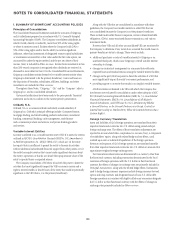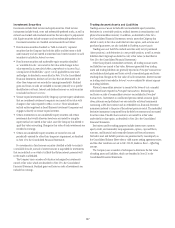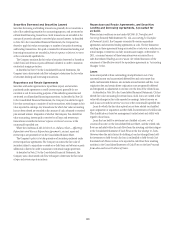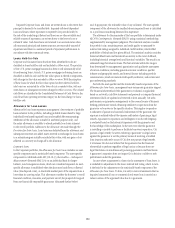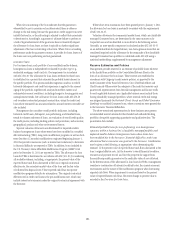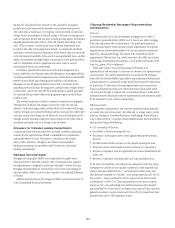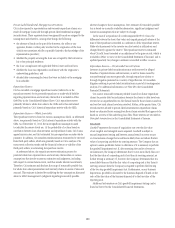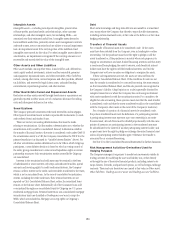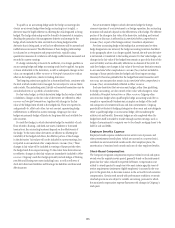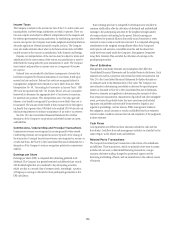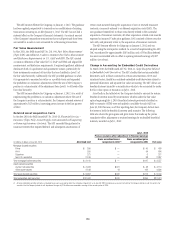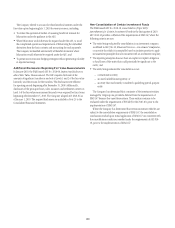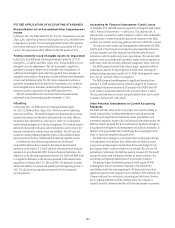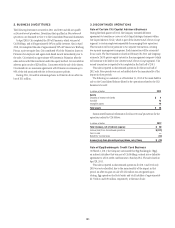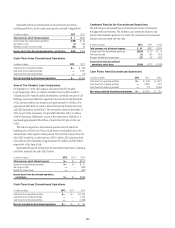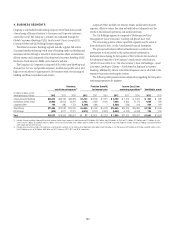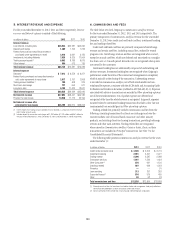Citibank 2012 Annual Report Download - page 176
Download and view the complete annual report
Please find page 176 of the 2012 Citibank annual report below. You can navigate through the pages in the report by either clicking on the pages listed below, or by using the keyword search tool below to find specific information within the annual report.154
Intangible Assets
Intangible assets—including core deposit intangibles, present value
of future profits, purchased credit card relationships, other customer
relationships, and other intangible assets, but excluding MSRs—are
amortized over their estimated useful lives. Intangible assets deemed to
have indefinite useful lives, primarily certain asset management contracts
and trade names, are not amortized and are subject to annual impairment
tests. An impairment exists if the carrying value of the indefinite-lived
intangible asset exceeds its fair value. For other intangible assets subject to
amortization, an impairment is recognized if the carrying amount is not
recoverable and exceeds the fair value of the intangible asset.
Other Assets and Other Liabilities
Other assets include, among other items, loans held-for-sale, deferred tax
assets, equity method investments, interest and fees receivable, premises
and equipment, repossessed assets, and other receivables. Other liabilities
include, among other items, accrued expenses and other payables, deferred
tax liabilities, and reserves for legal claims, taxes, unfunded lending
commitments, repositioning reserves, and other matters.
Other Real Estate Owned and Repossessed Assets
Real estate or other assets received through foreclosure or repossession are
generally reported in Other assets, net of a valuation allowance for selling
costs and subsequent declines in fair value.
Securitizations
The Company primarily securitizes credit card receivables and mortgages.
Other types of securitized assets include corporate debt instruments (in cash
and synthetic form) and student loans.
There are two key accounting determinations that must be made
relating to securitizations. Citi first makes a determination as to whether the
securitization entity would be consolidated. Second, it determines whether
the transfer of financial assets to the entity is considered a sale under GAAP. If
the securitization entity is a VIE, the Company consolidates the VIE if it is the
primary beneficiary (as discussed in “Variable Interest Entities” above). For
all other securitization entities determined not to be VIEs in which Citigroup
participates, a consolidation decision is based on who has voting control of
the entity, giving consideration to removal and liquidation rights in certain
partnership structures. Only securitization entities controlled by Citigroup
are consolidated.
Interests in the securitized and sold assets may be retained in the form
of subordinated or senior interest-only strips, subordinated tranches, spread
accounts and servicing rights. In credit card securitizations, the Company
retains a seller’s interest in the credit card receivables transferred to the trusts,
which is not in securitized form. In the case of consolidated securitization
entities, including the credit card trusts, these retained interests are not
reported on Citi’s Consolidated Balance Sheet; rather, the securitized loans
remain on the balance sheet. Substantially all of the Consumer loans sold
or securitized through non-consolidated trusts by Citigroup are U.S. prime
residential mortgage loans. Retained interests in non-consolidated mortgage
securitization trusts are classified as Trading account assets, except for
MSRs, which are included in Mortgage servicing rights on Citigroup’s
Consolidated Balance Sheet.
Debt
Short-term borrowings and long-term debt are accounted for at amortized
cost, except where the Company has elected to report the debt instruments,
including certain structured notes, at fair value or the debt is in a fair value
hedging relationship.
Transfers of Financial Assets
For a transfer of financial assets to be considered a sale: (i) the assets
must have been isolated from the Company, even in bankruptcy or other
receivership; (ii) the purchaser must have the right to pledge or sell the
assets transferred or, if the purchaser is an entity whose sole purpose is to
engage in securitization and asset-backed financing activities and that entity
is constrained from pledging the assets it receives, each beneficial interest
holder must have the right to sell the beneficial interests; and (iii) the
Company may not have an option or obligation to reacquire the assets.
If these sale requirements are met, the assets are removed from the
Company’s Consolidated Balance Sheet. If the conditions for sale are not
met, the transfer is considered to be a secured borrowing, the assets remain
on the Consolidated Balance Sheet, and the sale proceeds are recognized as
the Company’s liability. A legal opinion on a sale is generally obtained for
complex transactions or where the Company has continuing involvement
with assets transferred or with the securitization entity. For a transfer to be
eligible for sale accounting, those opinions must state that the asset transfer
is considered a sale and that the assets transferred would not be consolidated
with the Company’s other assets in the event of the Company’s insolvency.
For a transfer of a portion of a financial asset to be considered a sale,
the portion transferred must meet the definition of a participating interest.
A participating interest must represent a pro rata ownership in an entire
financial asset; all cash flows must be divided proportionally, with the same
priority of payment; no participating interest in the transferred asset may
be subordinated to the interest of another participating interest holder; and
no party may have the right to pledge or exchange the entire financial asset
unless all participating interest holders agree. Otherwise, the transfer is
accounted for as a secured borrowing.
See Note 22 to the Consolidated Financial Statements for further discussion.
Risk Management Activities—Derivatives Used for
Hedging Purposes
The Company manages its exposures to market rate movements outside its
trading activities by modifying the asset and liability mix, either directly
or through the use of derivative financial products, including interest-rate
swaps, futures, forwards, and purchased options, as well as foreign-exchange
contracts. These end-user derivatives are carried at fair value in Other assets,
Other liabilities, Trading account assets and Trading account liabilities.




